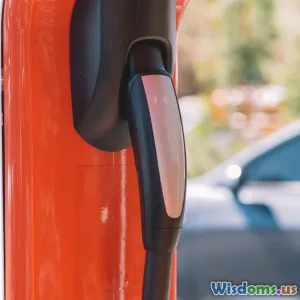
Rethinking Urban Transport: Electric Vehicles as a Solution
7 min read Explore how electric vehicles are revolutionizing urban transport by reducing emissions, improving mobility, and reshaping city life. (0 Reviews)
Rethinking Urban Transport: Electric Vehicles as a Solution
Urban centers worldwide are buzzing hubs of activity, innovation, and unstoppable movement. Yet, amid this vibrancy lurks a persistent issue: urban transport inefficiency coupled with escalating pollution. Traditional fossil fuel-powered vehicles heavily contribute to air degradation, traffic congestion, and climate change challenges. Against this backdrop, electric vehicles (EVs) emerge not just as a trend but a critical solution reshaping urban mobility paradigms around the globe.
The Urban Transport Dilemma
Cities face unique transport pressures—high population densities, limited space, and increasing demand for quick, efficient mobility. According to the International Energy Agency (IEA), transportation accounts for nearly 24% of global CO2 emissions, with urban vehicles at the forefront. The negative externalities include not just greenhouse gases but noise pollution and deteriorating public health.
Congestion in megacities like Los Angeles, Mumbai, or Beijing results in countless lost hours and economic productivity—estimated at billions of dollars annually. The ripple effect on the environment, economy, and quality of life drives the urgent need for alternative solutions.
Why Electric Vehicles?
Electric vehicles promise a holistic improvement over traditional internal combustion engines (ICEs). Their key strengths lie in:
- Zero Tailpipe Emissions: EVs produce no direct exhaust emissions. Cities like Oslo have shown a remarkable decrease in air pollutants as EV adoption soared to over 70% of new car sales.
- Energy Efficiency: Electric motors convert over 85% of electrical energy into movement, compared to around 20-30% for gasoline engines.
- Reduced Noise Pollution: EVs operate quietly, significantly lowering urban noise levels, enhancing the urban living environment.
Real-World Impact and Data
Consider Shenzhen, China—a city that replaced its entire fleet of 16,000 public buses with electric buses by 2019. This switch reduced approximately 1.35 million tons of CO2 emissions annually and lowered exposure to harmful diesel exhaust, benefiting the health of millions.
Similarly, London's Ultra Low Emission Zone (ULEZ) initiative incentivizes electric vehicle use, leading to substantial drops in nitrogen dioxide (NO2) levels.
Infrastructure: The Backbone of EV Urban Integration
EV success depends on accessible and robust charging infrastructure. Urban areas, traditionally designed around fuel stations, need to adapt. Innovative approaches include:
- Public Fast-Charging Stations: Cities like Amsterdam are installing fast chargers in highly trafficked areas to facilitate quick turnarounds.
- On-Street Charging Solutions: Integrating charging points in parking spaces and lampposts lowers the barrier for residents without private garages.
- Smart Grid Synergies: EVs can complement renewable energy usage, charging during off-peak hours and even supplying power back to grids when idle.
This infrastructure evolution encourages wider EV adoption, addressing range anxiety and convenience.
Economic and Social Dimensions
While the upfront cost of electric vehicles is higher, total ownership costs are increasingly competitive due to lower fuel and maintenance expenses. Many governments worldwide offer incentives:
- Tax credits in the U.S. allow buyers up to $7,500 off EV purchases.
- The European Union’s Green Deal allocates billions to clean transport subsidies.
Moreover, EVs foster social equity via new shared mobility models. Electric car-sharing and ride-hailing services in cities like Paris have lowered car ownership burdens while expanding access to clean transport options.
Challenges and Considerations
Transitioning urban transport is complex. Challenges include:
- Battery Production and Recycling: While EVs reduce operational emissions, battery manufacturing involves raw materials like lithium and cobalt, raising ethical and environmental concerns.
- Electrical Grid Demand: Significant EV penetration pressures urban power grids, requiring upgrades and renewable energy integration.
- Behavioral Shifts: Public acceptance, vehicle range, and performance perceptions must improve through education and transparency.
Proactive policies, technological advances, and stakeholder collaboration are essential to overcoming these hurdles.
The Future: Beyond Cars
Urban transport modernization leverages electric vehicles as cornerstone technology but extends to broader mobility ecosystems:
- Electric Buses, Bikes, and Scooters: Diversifying modes to address short-trip efficiency and last-mile connectivity.
- Autonomous Electric Vehicles: Self-driving EVs promise optimized traffic flow and enhanced safety.
- Integrated Mobility Platforms: Apps that unify public transport, EV rental, and real-time traffic data offer seamless, green urban journeys.
Cities like Singapore and Copenhagen are pioneering these integrated approaches, setting benchmarks for others.
Conclusion
Electric vehicles are more than a technological upgrade; they represent a fundamental rethink of urban transport’s sustainability and efficiency. Their role in decarbonizing cities, improving public health, and enhancing quality of life is demonstrated by successful case studies worldwide. However, maximizing their potential requires comprehensive infrastructure development, thoughtful policy, and societal embrace.
As urban populations swell and climate urgency intensifies, embracing electric vehicles in concert with innovative transport strategies will be pivotal in shaping livable, resilient cities for future generations. The road ahead is electric—and forging it demands our collective commitment today.
References:
- International Energy Agency (IEA) - Global EV Outlook 2023
- Shenzhen Bus Electrification Data - Shenzhen Municipal Government
- London's ULEZ Impact Report
- US Department of Energy - EV Incentives Summary
- European Commission - European Green Deal
Rate the Post
User Reviews
Other posts in Urban Planning
Popular Posts
















